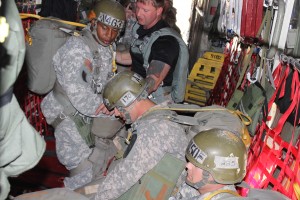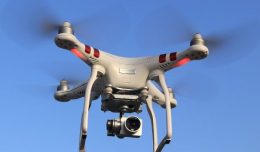Dropping something out of an airplane is generally frowned upon for most people because you never know where that thing you dropped is going to land or whom it might hurt. However, in the C-130, dropping things out of our airplane is what makes us different from UPS or FedEX; that, and landing on dirt strips that are only 3000 feet long.
In the history of the US military, a number of significant drops really changed the face of the wars where they took place. As a member of the 50th Airlift Squadron, I am proud of the heritage that has been left to me by those who participated in those airdrops, including D-Day — probably the most famous airdrop of all.
The HBO series Band of Brothers (which if you haven’t seen, I highly recommend) made that airdrop known to my generation and really reinforced the dangerous nature of those types of missions. Another fascinating part of that series was the training and transforming of those men into paratroopers to prepare them to make that fateful jump.
In the decades since that jump, not a ton has changed in the training. Sure, the equipment has improved; though not exactly the same, it still follows the same basic pattern. That includes using three of the four 250-foot jump towers at Ft. Benning where the training continues to take place.
Fortunately for the jumpers, airdrops aren’t conducted with the C-27 anymore (though I personally would love to try that out). The military now utilizes the C-130, and I have been fortunate enough to support that training three times.

We cram as many people as possible on the plane which is no easy task with all of the jumpers’ gear.
Jump week involves the students performing five jumps utilizing two different parachutes in three days, assuming weather and other conditions work out. Sometimes that includes a night jump, but it is usually the first thing eliminated to ensure the training gets completed. There is also always a combat equipment jump which is around 30 pounds or so of equipment strapped to the jumper.
The days can start as early as 3 AM during jump week to ensure that all of the proper preparations are made and that the entire class (usually around 400-450) is ready to jump.
First thing Monday morning, the flight crews meet with leadership to brief the events of the week and ensure everyone is on the same page. This includes jump times, locations, chute types, weights and any other information needed to ensure a safe and successful jump week.
After that briefing, the jumpmasters come out to inspect the plane, making sure that all of the equipment is safe and functional. At this time we also brief with our jumpmasters to ensure we are all on the same page in terms of hand signals, emergency procedures and expected winds. As the navigator, this is incredibly important to me as I am responsible for getting the jumpers onto the drop zone safely.
Once we are all briefed, we start the engines and taxi to the staging area to load up our troopers. We usually load about 50-60 jumpers for each lift; if you have two functional planes, it usually takes four lifts to get all of the jumpers through each jump.
Once the plane is loaded, we taxi out to the runway and take off for the drop zone. It’s a short trip since the drop zone is only about three miles from the runway. Because it’s so close, the work starts immediately. In the front of the plane I am ensuring that I have input all of the data properly to get a good drop solution. I’m also working with the pilots to get us set up properly for the turn back in to the drop zone.
In the back, the loadmasters are prepping the plane for the jumpers. Once the clearance is given from the pilot, the loadmasters open the paratroop doors and do their checks to make sure it is safe to jump. They then give the door to the jumpmasters so they can do their own checks. As you can see in the video, they even inspect the outside of the plane. Keep in mind that we are traveling at 130 knots while they lean out. Once they are ready in the back, I direct the turn back in towards the drop zone.
At a predetermined point the loadmaster gives the door to the jumpmaster for the remainder of the run-in. As the navigator, I am passing back time status updates to the jumpmasters as well as wind information to help them gauge their position. They also have a handful of ground references that they are looking for as checkpoints on the run-in.
As you can tell from the audio on these videos, it is incredibly loud in the back of the plane. With four engines roaring and the wind whipping in, it is almost impossible to communicate normally. For that reason, the loadmasters and jumpmasters utilize a number of hand signals to convey information.
Shortly before crossing the drop zone, the jumpmaster leans out for one more look to ensure we are in position and then steps back to allow the jumpers to come to the door ready to jump. One jumpmaster ensures the static lines are kept free from tangling while the other guides the jumpers to the door.
You may also notice in the videos that one jumpmaster has his eyes glued on something throughout the duration of the jump. He’s looking at two lights located both forward and above the troop doors as well as in the aft side of the door frame, one red and one green. These lights tell the jumpmaster when I as the navigator feel the plane is in a safe position to drop.
As we near the drop zone everyone has a job to do. The jumpmasters have their eyes glued on the lights waiting for the red to go out and the green to turn on. The loadmasters are watching over everything in the back to make sure it is safe for everyone involved. The engineer is monitoring the systems to make sure the plane is functioning properly.
One pilot has a hand on the light switch waiting for the command to switch it on, while the other is holding a steady altitude, airspeed, and heading. The navigator is monitoring the pilot’s actions and waiting until just the right time to make that ever important call: green light!
At that point the pilot flips on the green light. When the jumpmaster sees the green light they start funneling jumpers out the door. This continues until either all the jumpers get out, or we run out of drop zone and the red light comes back on, which happened in one of the videos here. Once the jumpers are out, the jumpmaster leans out again to make sure that they all got away cleanly.
If there are still jumpers on the plane, then we turn back outbound and go through the whole process again. Each pass takes about five to ten minutes depending on a number of factors including where the other plane is in the pattern. Once all of the jumpers are out, we close up the doors and make the short, three-mile jump back to the airport to start all over again.
This pattern is replicated with only minor variations until all of the students get their five jumps. It really is impressive how efficiently the whole operation is carried out, especially when you consider that they do the same thing pretty much every single week, qualifying people from all segments of the Department of Defense to be jump-certified.
Personnel airdrops have been a critical part of our military’s abilities for a long time, and they continue to be important today. The men and women of the 1st Battalion, 507th Parachute Infantry Regiment perform their mission like a well-oiled machine, and it is a privilege to work with them to accomplish it.
To learn more about the complete training, visit the 1st Battalion, 507th Parachute Infantry Regiment which currently conducts the training.
David Lynn is a C-130 navigator in the USAF and a proud avgeek. You can follow him on twitter @davidvlynn or via his blog AviationGuy.com.







